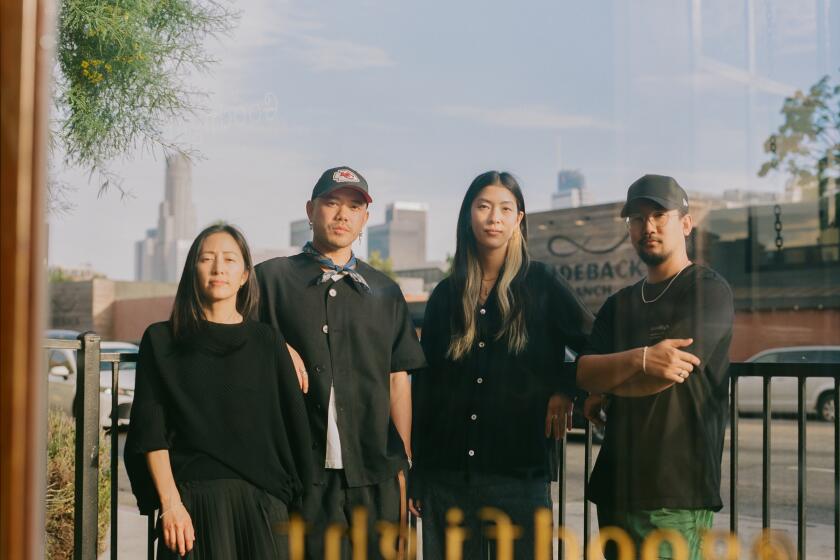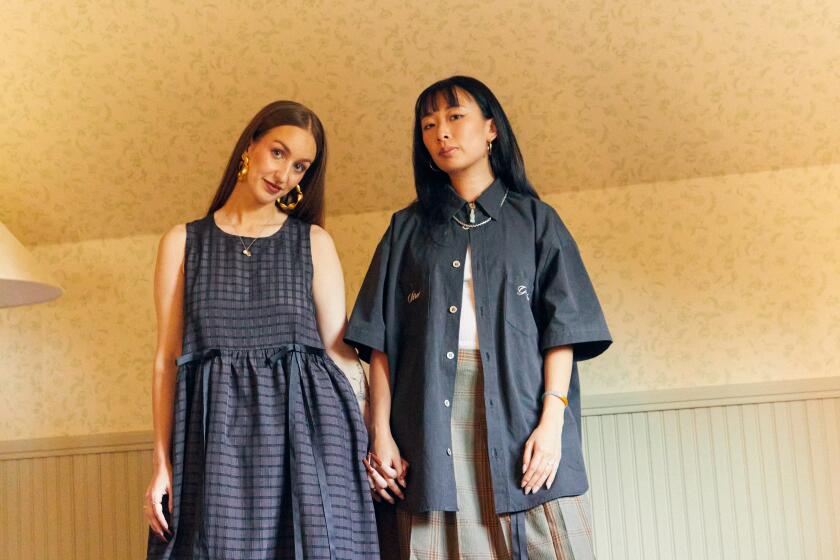
- Share via
Walking into Firmé Atelier, shrouded inside of a warehouse studio on a corner of downtown L.A., is like stepping into a gothic Catholic church. Everything inside, from floor to high ceiling, is black, with custom shelving, a velvet couch and intricate moldings on the furniture. The air is slightly crisp in here, quiet enough to hear your own thoughts. Thick smoke of burning incense penetrates the room, perfuming everything sacred. There’s a pulpit off in one corner, a massive skull in another. “The idea was an altar for the clothes, because the clothes are so special,” says Paul Um, visual director and co-founder of Firmé Atelier along with Eric Kim, who is head of operations. “How do you encapsulate that within a place?” Kim adds: “It’s a part of the experience when you get a piece from us.”
Bespoke clothing is not an everyday occurrence — but Firmé Atelier might argue that it is a kind of religious one. Along with doing garment development for other brands, Firmé specializes in custom, one-of-one pieces — mostly suiting — that has a distinctly L.A. spirit with the help of Kim’s (and his team’s) perfectionist eye for shape and proportions, and Um’s design of speciality hardware that adorns signature looks. Firmé Atelier creates a space where alchemy can happen via super 150s grade wool. There’s something supremely intimate about having a designer like Kim create a custom suit for your specific shape and identity out of thin air — one that you wear for some of the most special occasions of your life. Getting the piece becomes a special occasion in itself.

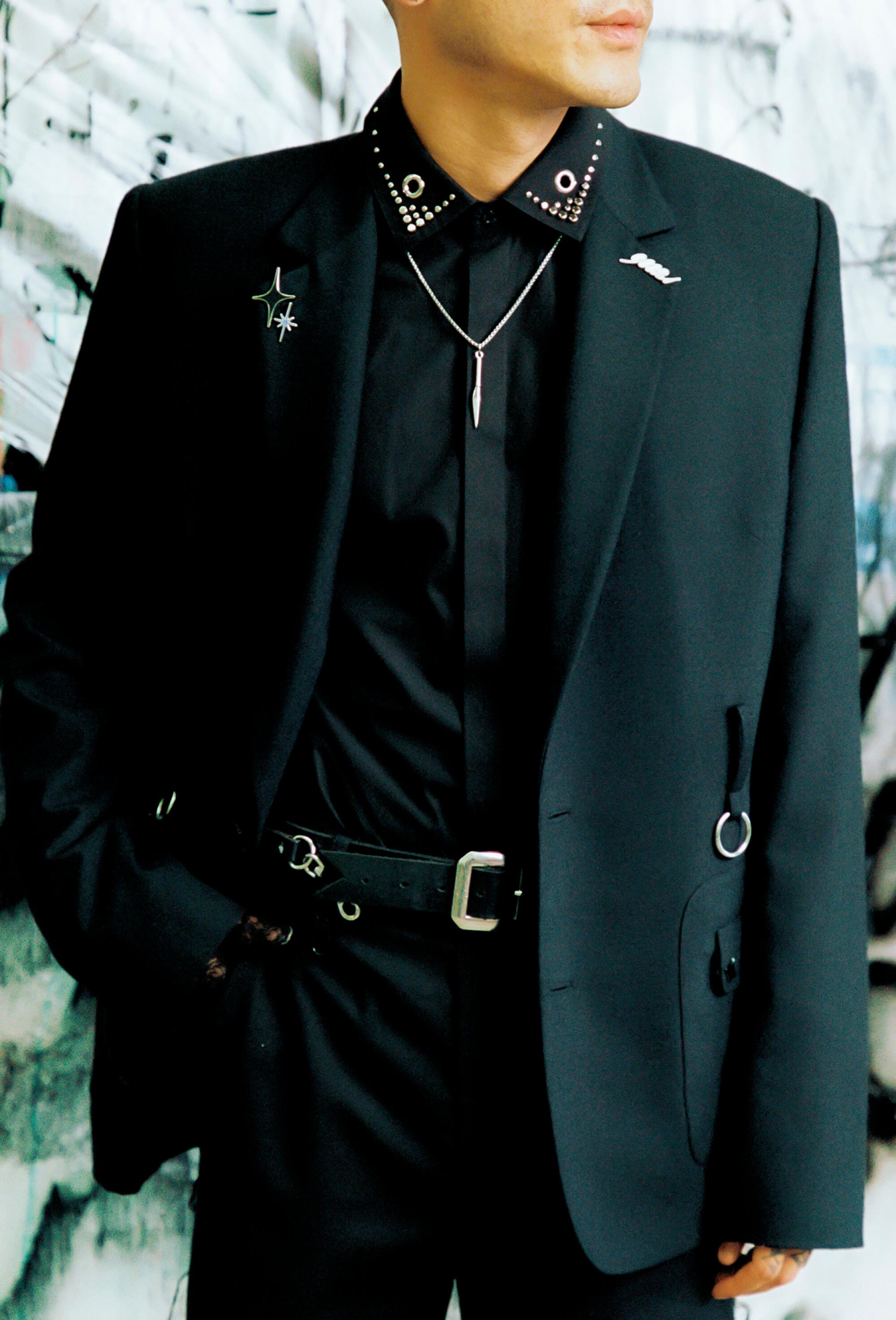
Firmé Atelier was founded in 2018 by Kim, 29, and Um, 28, because they wanted to shake up the manufacturing game in L.A. Kim’s experience cutting his teeth at factories in the area taught him that this was a T-shirt, hoodie and denim town. There was dire need for a place that dared to step into edgier, more ambitious construction, with a multigenerational, multicultural team. Firmé’s bread and butter, what they started with, was brand development. A brand — let’s say Kappa — will bring them a sketch or a reference, and Firmé’s team will make it from scratch, creating the prints, sourcing the fabric, zippers, trim, buttons, and, in the end, turning a mere idea into a tangible object. The bespoke pieces they create for artists like Lil Uzi Vert, who wore a pink and black American flag jacket on the cover of his latest album, are another part of the equation. But the suits are Firmé’s specialty — what they’re coming to be known for in L.A. and far beyond.
Smart fashion is not about an aesthetic. The brand once called a cross between Comme des Garçons and Levi’s knows that it’s about putting something extra on it just for you.
The atelier is in the process of completing releasing its first permanent collection — which will be out by this year. It started as an experiment — a way to create a kind of menu of options for people walking in knowing they want something but have no idea what. With the collection, guests can point to a design and say: I want that silhouette, but fitted to me, Kim explains. “I have a system based around it where I take these building blocks and adjust them to your measurements. It was something I developed for a year and a half. I tweaked it so much. I tested it. Maybe too much.”
The design of the pieces is consistent with the suits Firmé has been putting out into the world over the last few years: a modern fit with a razor sharp focus on detail, and the flex of all things ornamental and personal. Kim freestyles as he goes and sees what comes up. There are remnants of Catholicism and the roaring ’20s in the collection. One of the suits features an asymmetrical jacket with a wave of pleats emerging from a raw cream trim on its front side, and a single belt loop for a carabiner clip. The pants have a generous, relaxed break accentuated by handmade silver pins. Um noticed that, creatively, he had never seen Kim show up as fully when designing as he did with this collection. There was a fierce dedication to the form, and the function followed.
“Also, I wanted to flex that skill,” says Kim of suiting. “People don’t do this because they can’t.”
The art of making a bespoke suit starts long before scissors meet fabric. It’s about the person first: their story, their desire. Kim sits down and has a long conversation with his client. “Do you want single breasted or double breasted? Do you want a coat? Do you want it baggy? Do you want it slim? What color? What fabric?” Kim works with Jonathan Lee on these jobs, an in-house designer on his team, and frequent collaborator and friend. Lee comes up with a sketch of the design including a rendering of the actual person who is going to wear it — which the client gets to keep as a memento. Once the sketch is approved, the client will come to Firmé’s showroom, where Kim measures them, then creates the pattern and buys the fabric. He will do a preliminary fitting while the suit is halfway done to catch any imperfections in the fit, then he and his team make it.
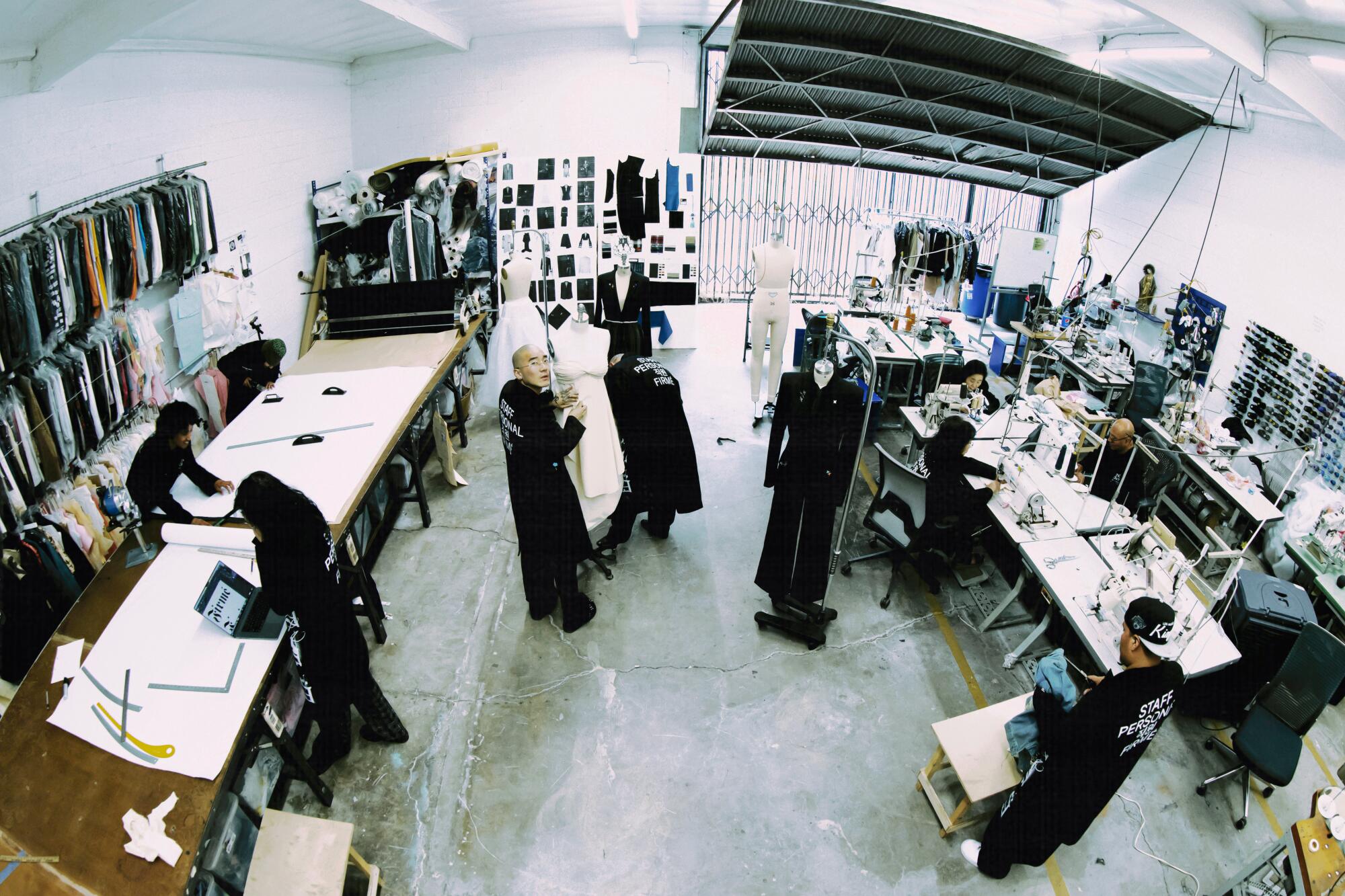

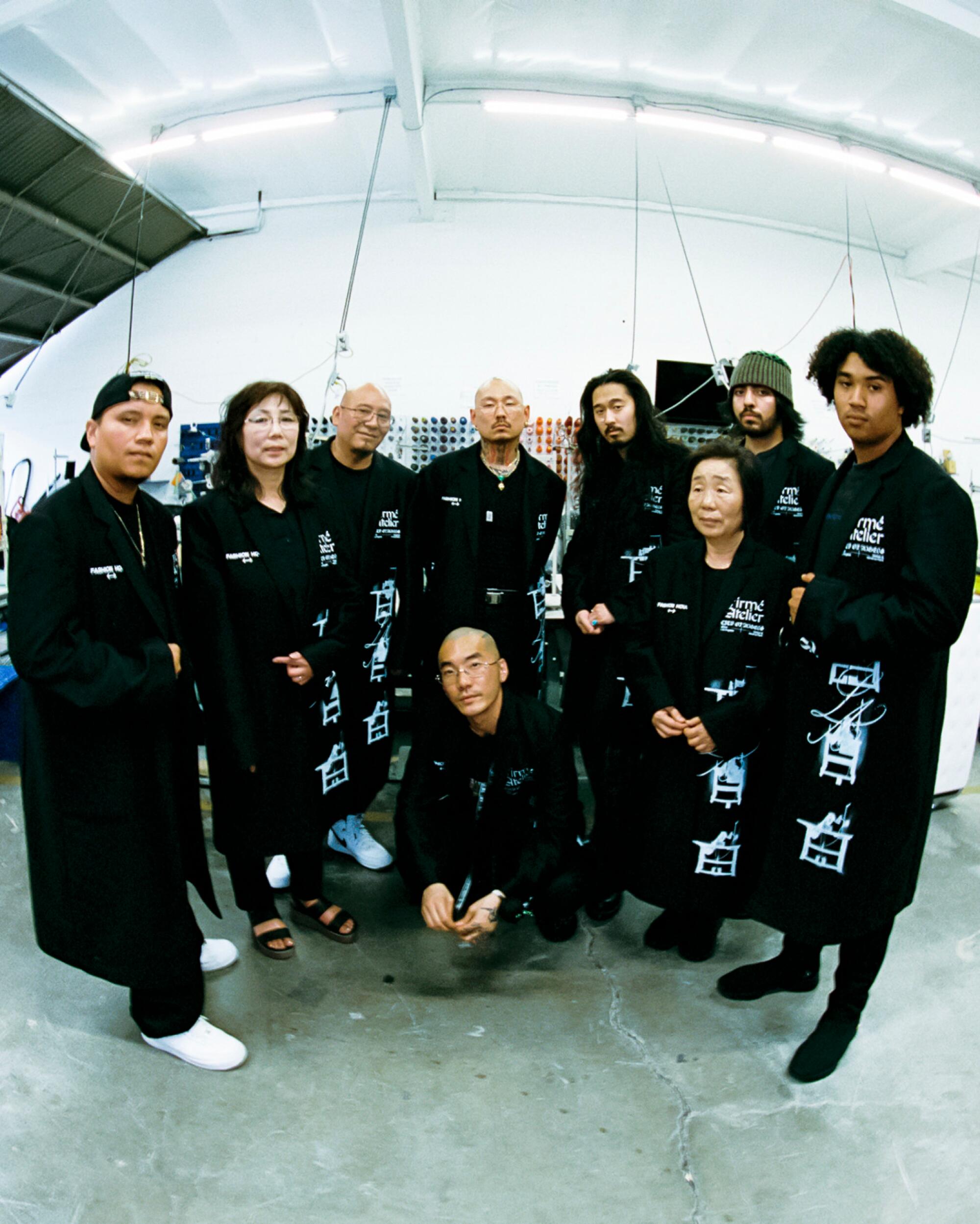
“It’s really special,” Kim says. “I see the reaction when someone gets their suit, when they try it on. I can feel this energy that I get from them. They’re like, ‘Oh, my god. I’ve never looked this good in my life.’ Nothing you buy off the rack is going to be perfect. But when I make it for your body … it just hangs on you perfectly.”
Oversized is a lifestyle, not a trend for the brand from the San Gabriel Valley. Its designs are driven by the idea of feeling like you can grow, change and move around in clothing.
The process not only requires a certain way with people, but also an obsession with the minutiae. One of the reasons it’s so difficult is because there is so much room for error. “It’s not like a hoodie,” Kim says. “Anyone could throw on an XL hoodie and be straight. A suit is more scientific.” In the process, Kim becomes an anthropologist, an anatomist and a mathematician. He studies the way someone’s body moves around a room, he knows that people who work out consistently have straighter backs, or those who sit at a computer all day might have a slight hunch, and he adjusts the patterns accordingly. “That’s the difference between me and whoever else,” Kim says. He learned pattern making and tailoring at Los Angeles Trade-Technical College and through private lessons, but his on-the-job experience was always leading him to the next, more difficult practice. He had learned how to make a T-shirt long ago. He learned how to make jeans. Suiting was the thing he invested the most time and dedication into. It felt serious, complicated, something he wanted to get right each time. “If you’re gonna sell a suit for four bands,” Kim says. “It has to be good.”
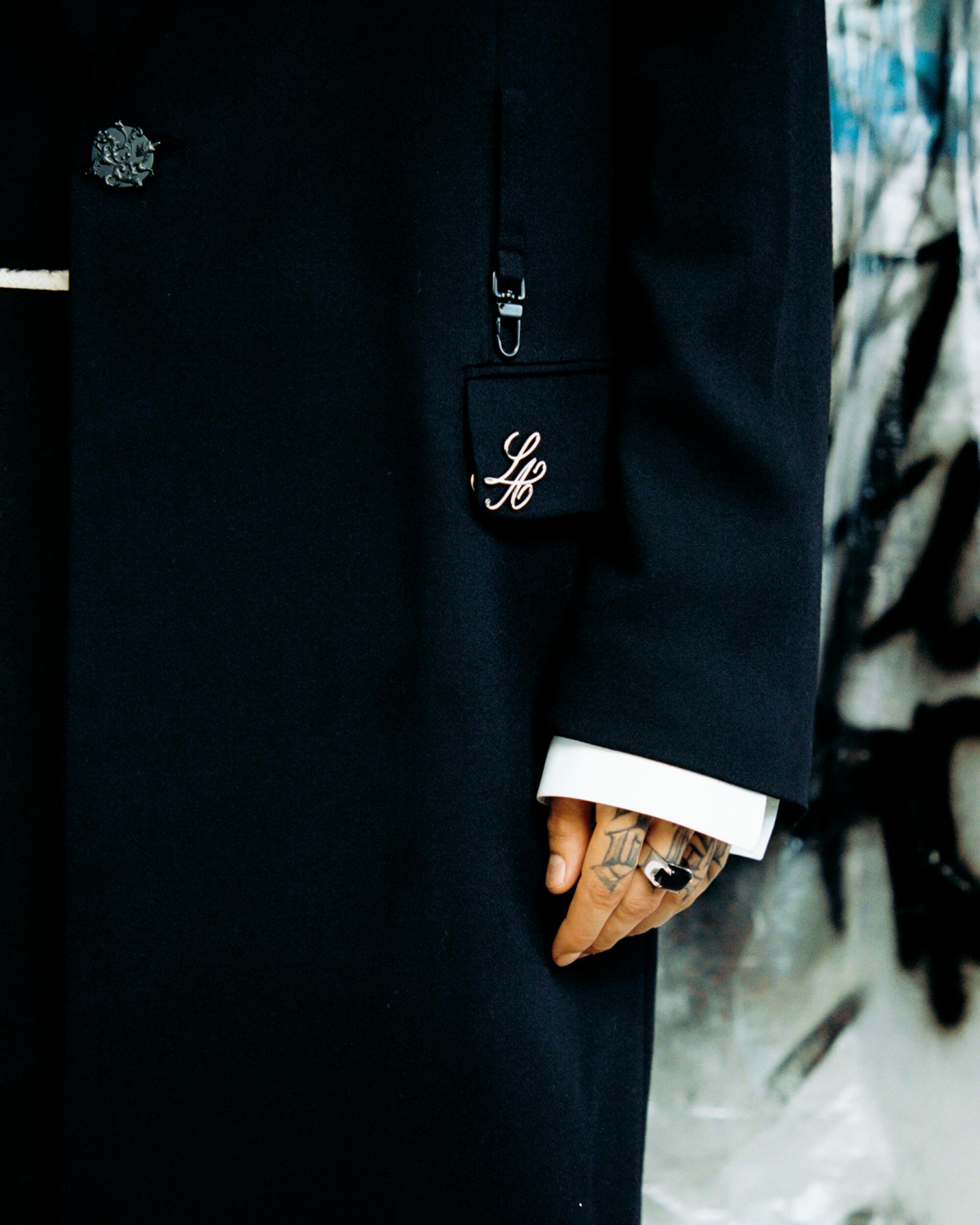
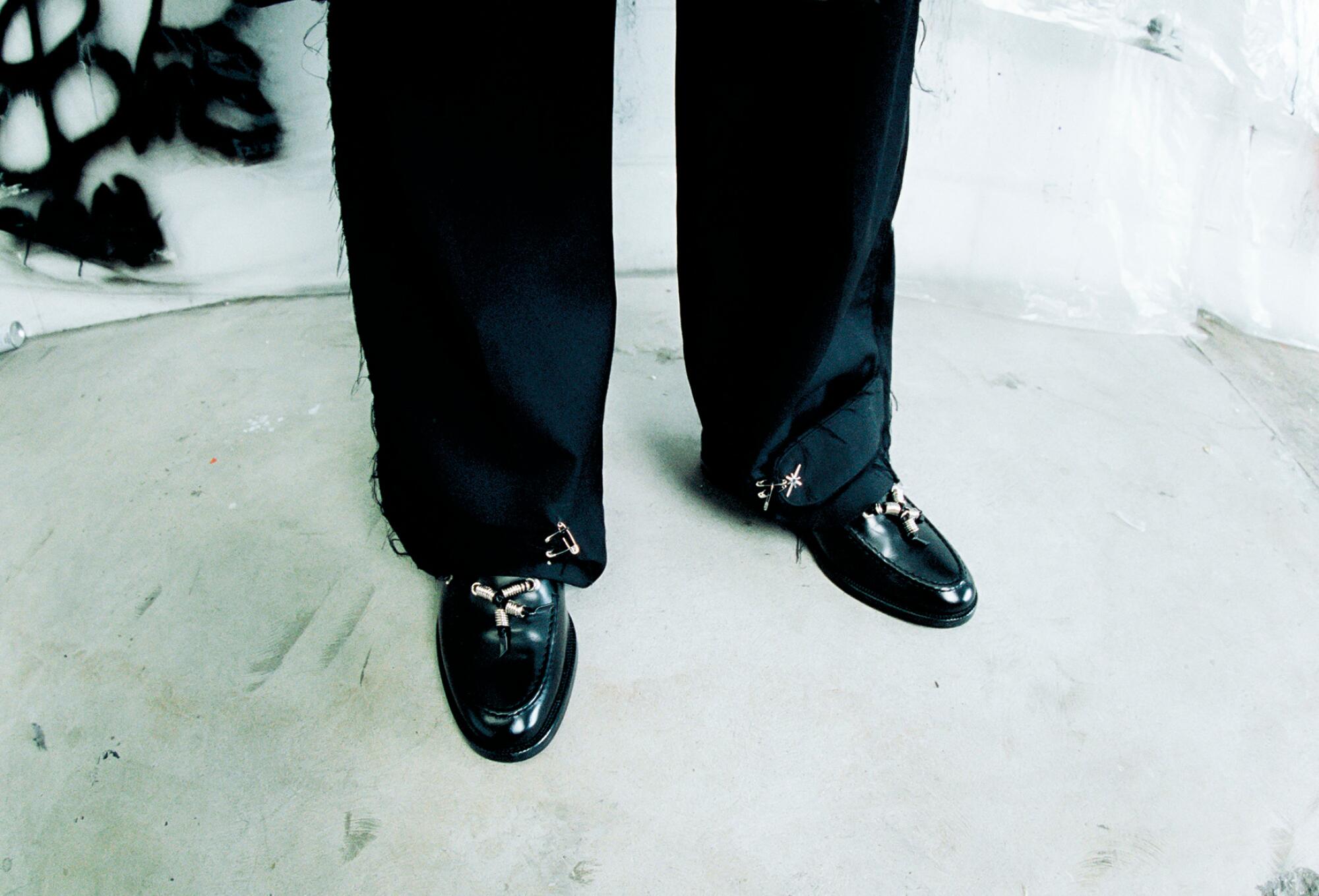
The ornamental aspects of a Firmé Atelier suit give it its stamp. The lining and hardware gifts each piece with a personality that’s fly but not trying too hard — polished but still youthful enough to feel like you’re wearing an individualized garment. Firmé’s accents give the suit — a historically stuffy silhouette — a particular edge, like tattoos on fabric. These custom details include pins in the shape of various four point stars and the DTLA ZIP code where Firmé is located (90021), along with silk lining in intricate floral or pop art patterns. The Firmé suits’ custom hardware and silk lining are all designed by Um, who studied graphic/type design at CalArts. Um usually takes inspiration from ornamentation motifs of traditional patterns of cultural rugs. “They make the suits more interesting and modern and a little less serious,” says Kim.
The Taiwanese American artist’s designs are an antidote for a textile industry status quo that just talks the talk.
There’s a communal aspect to Firmé Atelier that you can feel in the clothes. You know many hands touched the pieces, put time and love and energy into them. Kim and Um grew up together — Kim lived in cities around Southeast L.A. and Orange County and Um in Cerritos — and started a streetwear brand together in high school long before founding Firmé.. Over time, they built a team that feels like family. Because of its intimate nature, creating suits for people often makes the wearer a part of Firmé’s community, too. Last year, Kim collaborated with Lee and Spanto, the late co-founder of Born X Raised, on a suit that he wore to his last Sadie Hawkins. There is a photo of Spanto by Carlos Jaramillo, standing in front of a waterfall of red satin curtains at the party, looking proud in his all-black suit embellished with traditional Navajo pieces by Thundercloud Jewelry. Kim cherishes the photo. Spanto invited Kim and Lee to begin working with Born X Raised shortly after, where Kim currently has his hand in collaborations, handling the cut and sew collections and special projects for the brand.
When Spanto tragically died in an accident in June, his wife called Kim and Lee to make the suit he would be laid to rest in — a waterbird-themed suit, with hardware and the same leather patches Spanto used in his final Born X Raised collection — a collaboration with Levi’s honoring his Native heritage and family. “That is probably one of the most special pieces that I’ll ever make,” Kim says.
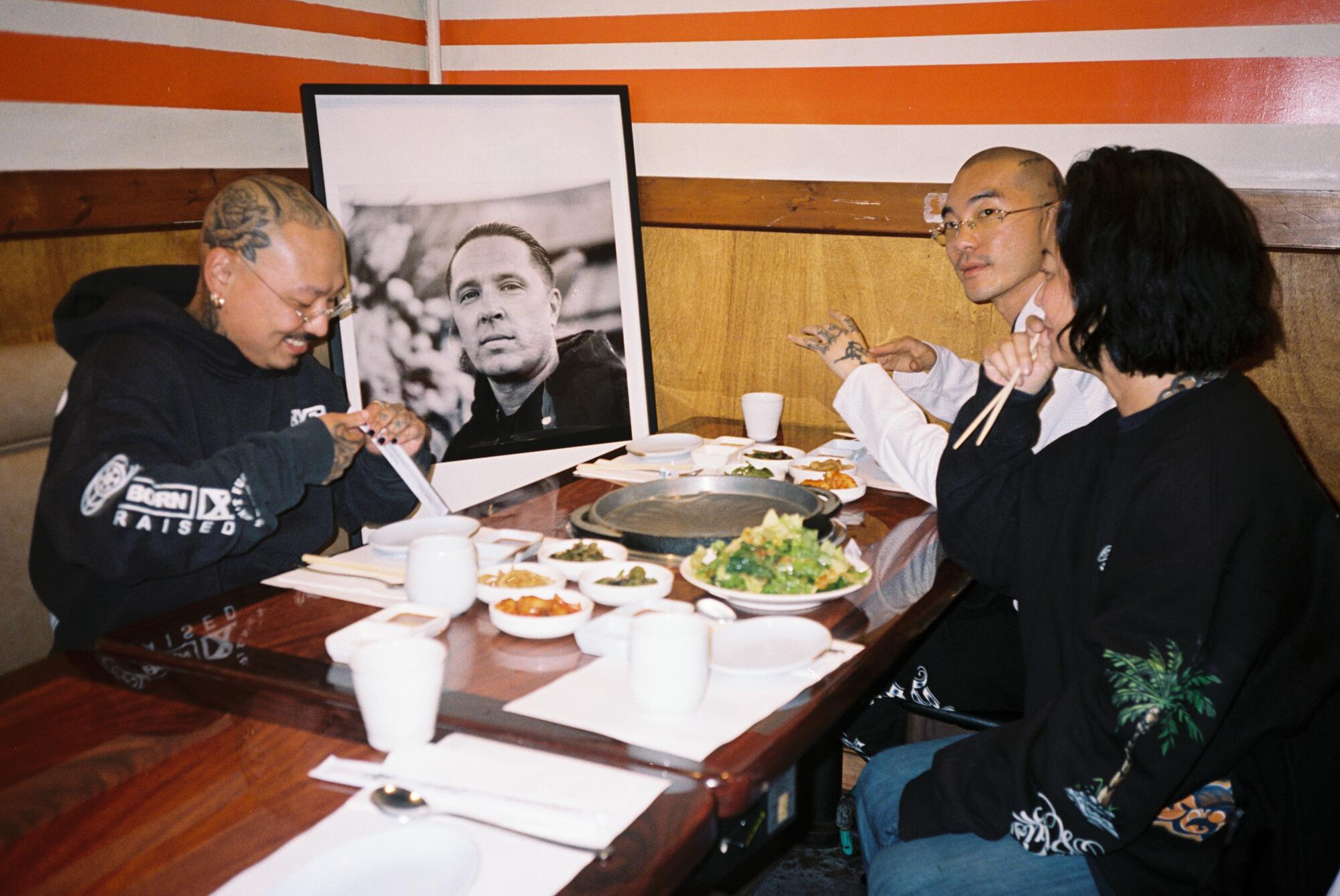
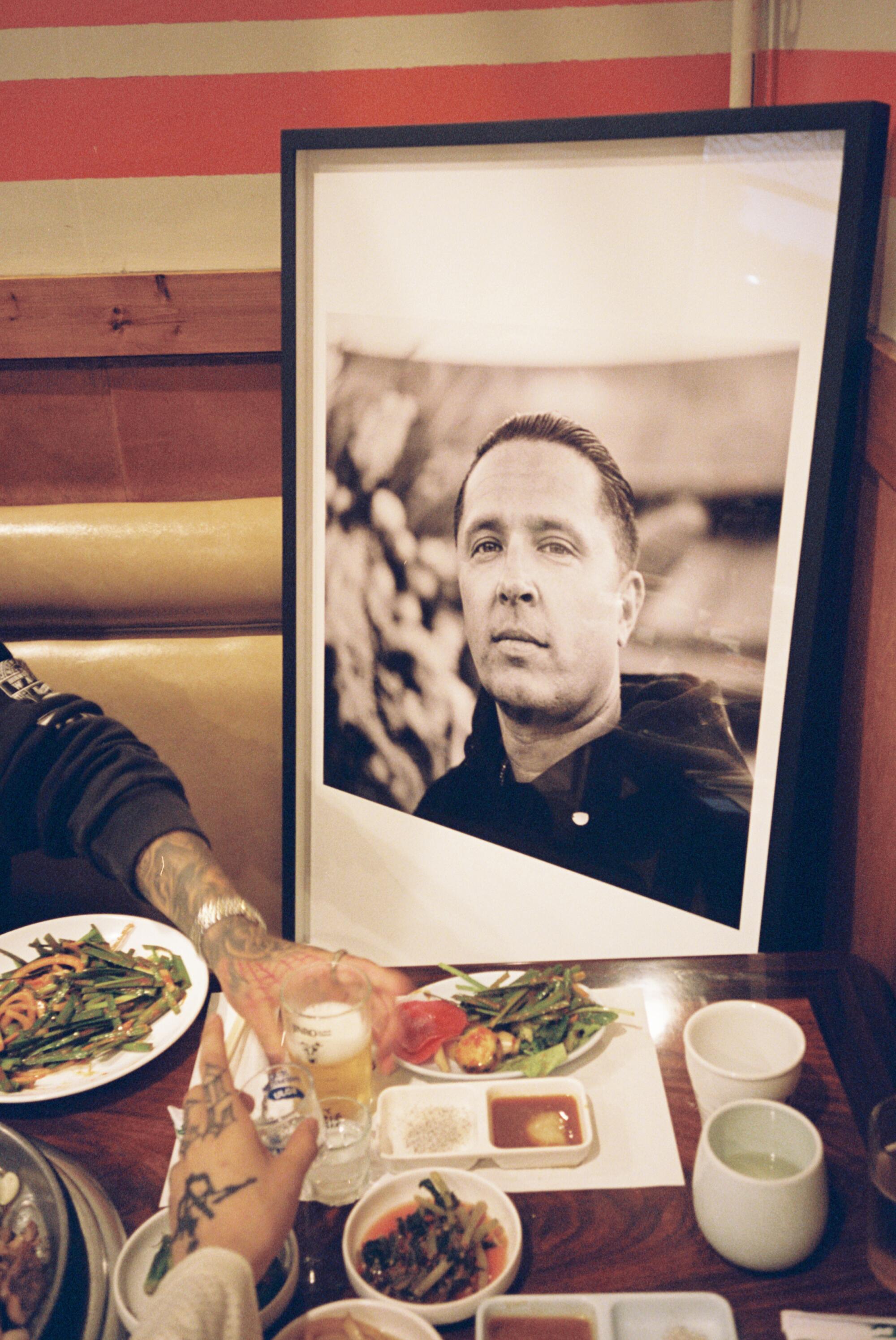
Kim and Um met in church as kids; they were even baptized together. There exists a photo of them when they were little, bowl cuts going strong, after having their sins washed away. And the place of their initial connection has bled into their lives both aesthetically — Kim still wears devotional scapulars around his neck, and you can see the influences at their studio and in their work — and ethically. “There was a rigidness in Catholicism,” Um says. “Which I think did foster some kind of attitude. What we do, that’s religion for us.”
There’s a classic feeling to L.A.’s favorite regalia that transcends genre and class. Every time you freak it, you step into a high-fashion world that is all your own.
There’s an asceticism to bespoke suit making that can be found in the religion as well. The self-discipline needed to practice one’s faith — to observe, let’s say, Lent — is the same one required when adjusting mere centimeters on a pattern. There’s an undeniable rigor and intensity that overlaps. For five years, Firmé has been reaching toward perfection with its craft. Each new suit is a chance at creation, of moving toward sanctitude. “Suiting is the final form of making clothes,” Kim says.
“Suiting is the final form of making clothes,” Kim says.
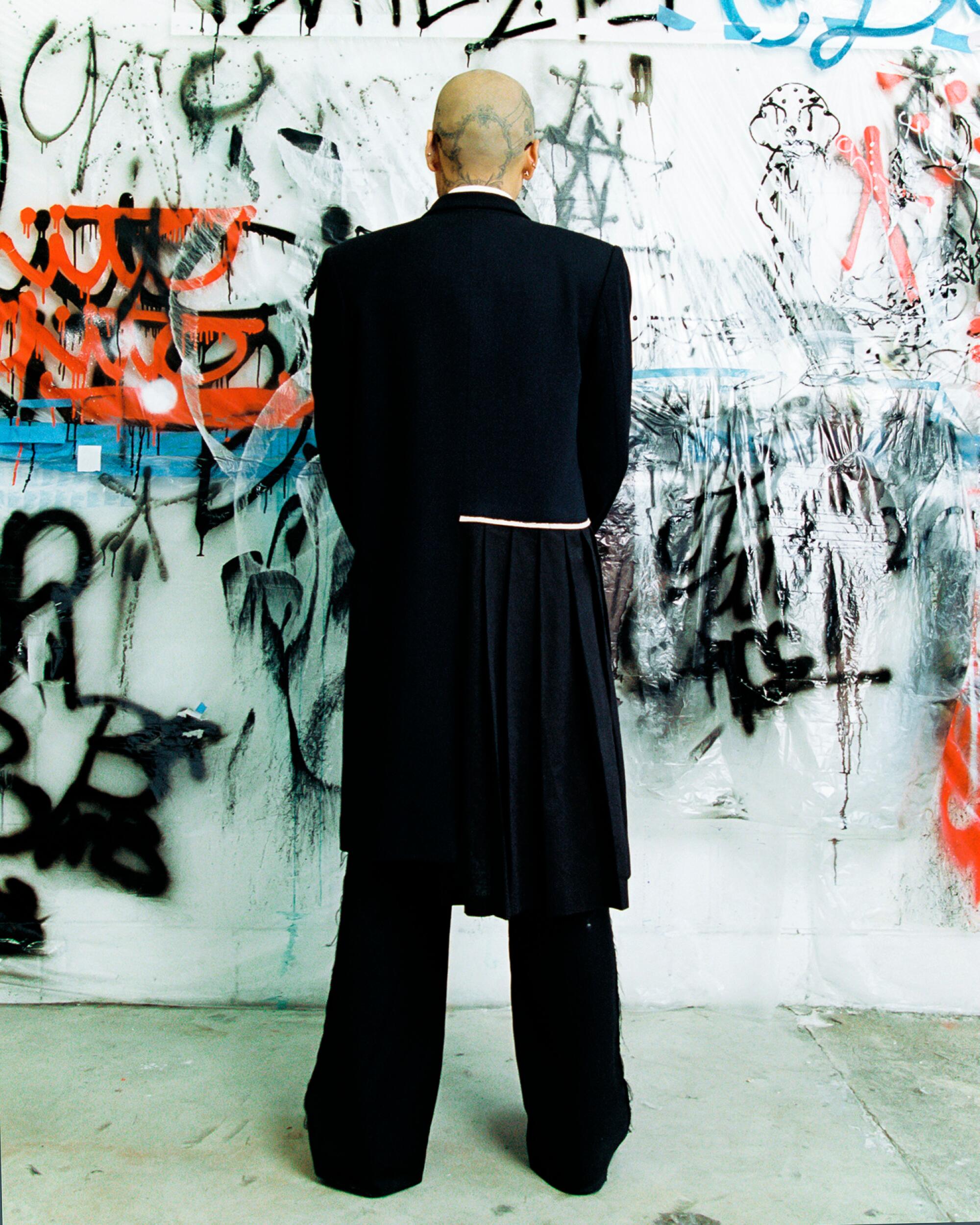
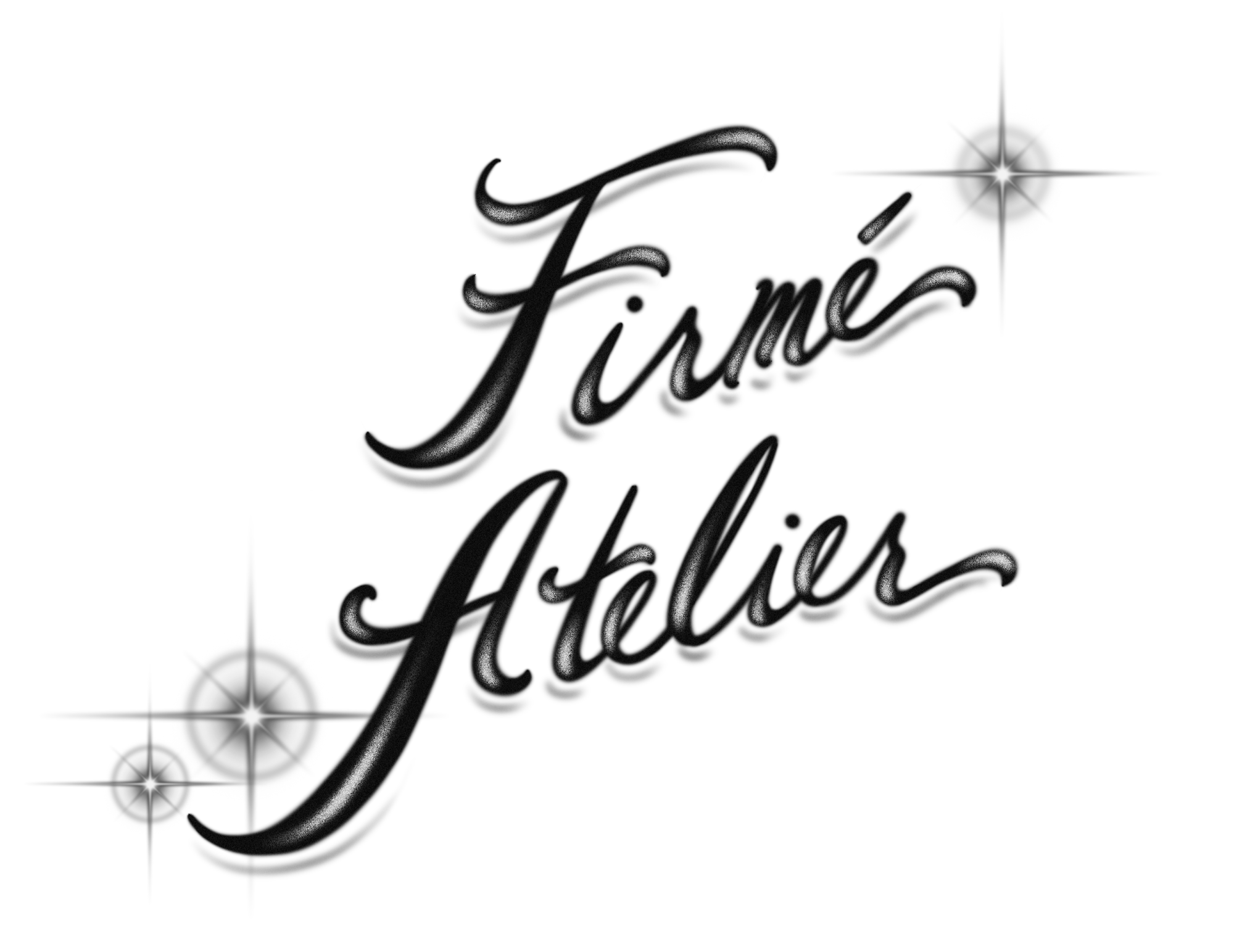
Lettering by Jake Garcia / For The Times


